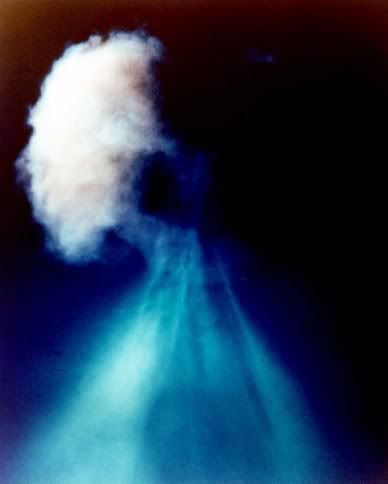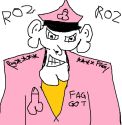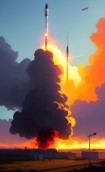|
I'd do an effortpost on just how insane Team B was, but I'm really tired right now, so I'm requesting that.
|
|
|
|
|

|
| # ? Apr 18, 2024 14:04 |
|
Good thread. I think a write up on the development of the 4th gen fighters would good only in that the changing threats combined with the politics of the post-Vietnam era military shuffle. Also development of aim-9x vis a vis the f-22 is also interesting stuff.
|
|
|
|
Smiling Jack posted:I'd do an effortpost on just how insane Team B was, but I'm really tired right now, so I'm requesting that. Yeah, I've mentioned their threat inflation a few times and it has been brought up by other people occasionally (that "First Strike" video I posted was done by the Committee on the Present Danger, which was the "think tank"/whatever where Team B got a lot of their analysts from), but it really needs to be laid out in concrete clear terms just how crazy their stuff was. I would do the post, but I feel like I need to actually read Arsenals of Folly all the way through first, and since I'm still working my way through Dark Sun, that could be a ways down the road. daskrolator posted:Good thread. Ooh...now you're getting into a topic I'm rather passionate about (F-22 and the various types of weapons it can or can't carry). Being a munitions officer at an F-22 base tends to do that to you. If anyone is actually interested in that specific topic I can copy+paste some stuff I wrote up at another place on that (most of it has to do with the -9X and the SDB)...I tend to try and keep myself restrained somewhat when discussing that stuff because I don't want to be "that guy" that inadvertently puts something out in the open that's not supposed to be. But yeah, development of the teen series fighters would also be a good one...maybe that will be next after the ones I mentioned before (which I promise I am actually working on).
|
|
|
|
Ygolonac posted:"Hey Dave, what's the weight of that reactor? How many tons? Slamming and rolling and total loss of cooling systems and controls and uranium is kinda mass-y, is there any chance it could get slapped into a critical mass?" I don't believe this. The possible avenues this crash could take would be:
In regards to massive radioactive release, there is no doubt. Uranium is not very radioactive (as in, we handle new fuel with our nearly bare hands), but its fission products are. This hypothetical airborne reactor would have been running, and would have plenty of highly active byproducts to spread in a crash. The risk of a detonation on the other hand is not there because the conditions required for creating an explosion of the kind we are familiar with from nuclear weapons is the result of painstaking engineering. Civilian nuclear reactors are perfectly capable of a meltdown with hundreds of times the critical mass required by their fuels. A nuclear fission [chain] reaction demands one key thing: Each fission should give rise to at least one neutron that successfully causes another fission. Depending on a lot of factors, each fission actually produces 2-3 neutrons regardless of whether you're busy satisfying or eliminating the electric demands of a city. Where did those 1-2 neutrons go? Well, they go a lot of places. A very large number are simply lost to the surroundings. That "critical mass" people talk about is just a thought experiment asking, "If we had this fissile material formed into the ideal shape, such that its neutrons reacted with itself as much as possible, and were lost to the environment as little as possible (i.e. a sphere), what would the mass be?" Geometry is terribly important, and very intentionally chosen. Let's say that reactor slammed into the ground, going from stable seven-brides-for-seven-brothers fission to being a mangled pile of ex-fuel elements. I bet you there'd be plenty of little local spots where the conditions were just right so that more neutrons that necessary were produced, causing the reaction to go faster and faster. It's not the end of the world. Those bits would just get very hot and, for example, vaporize. The formerly critical spot would turn into a hot gas, its density plummet, and the neutrons produced by each individual fission would be subject to a drastically higher chance of never participating in a fission reaction. Less than one successful child fission per parent fission means subcriticality and the (at least temporary) end of the reaction. Now, what makes those fission bombs so special that they destroy cities with less uranium than a few civilian fuel elements? Well, they have mechanisms in place to keep all that fissile material together so that it has a chance to react all at once. I'd like to compare it to how low explosives like gun powder need to be tightly wrapped in order to function as explosives, but that would be a lie. The proximity of the fuel to itself is controlling the reaction, and as soon as the reaction has forced the fuel apart (vaporization etc.) it's over, for now.
|
|
|
|
Groda posted:This is the smartest thing I've read in this forum this week. And probably month.
|
|
|
|
Groda posted:The risk of a detonation on the other hand is not there because the conditions required for creating an explosion of the kind we are familiar with from nuclear weapons is the result of painstaking engineering. Civilian nuclear reactors are perfectly capable of a meltdown with hundreds of times the critical mass required by their fuels. Of course, it wouldn't explode like a nuclear bomb - but it's worth thinking about what happens when you get to the "Those bits would just get very hot and, for example, vaporize," bit. You've got a bunch of little explosions, puffing highly radioactive poo poo into the air. It's not a city-destroying mushroom cloud, but it's a "holy poo poo" level radioactive event. Plus, even if the reactor has the decency to not explode at all, you've still got a big hot (in both senses) chunk of nasty poo poo, probably sitting in a pool of jet fuel, melting its way into your runway or some poor bastard's back yard. Again, not Hiroshima, probably not even Chernobyl, but still a disaster big enough to make the news worldwide for the next few weeks. Airborne reactors were environmentally untenable from the start, even among the decidedly non-green defense contractors and Air Force of the era.
|
|
|
|
I love my golf course.  Click here for the full 1600x1200 image.
|
|
|
|
Groda posted:Now, what makes those fission bombs so special that they destroy cities with less uranium than a few civilian fuel elements? Well, they have mechanisms in place to keep all that fissile material together so that it has a chance to react all at once. I'd like to compare it to how low explosives like gun powder need to be tightly wrapped in order to function as explosives, but that would be a lie. The proximity of the fuel to itself is controlling the reaction, and as soon as the reaction has forced the fuel apart (vaporization etc.) it's over, for now. That whole That said, this Space Gopher posted:Plus, even if the reactor has the decency to not explode at all, you've still got a big hot (in both senses) chunk of nasty poo poo, probably sitting in a pool of jet fuel, melting its way into your runway or some poor bastard's back yard. Again, not Hiroshima, probably not even Chernobyl, but still a disaster big enough to make the news worldwide for the next few weeks. Airborne reactors were environmentally untenable from the start, even among the decidedly non-green defense contractors and Air Force of the era. is also absolutely correct. As I mentioned before in this thread, there were not one but two instances of U.S. aircraft (B-52s, in both cases) crashing on or above foreign territory and having the high explosives on the bombs cook off as a result of the crash, covering the surrounding area with highly radioactive debris. In both cases, a major international incident resulted, and the two cases combined resulted in the ending of the Chrome Dome SAC continuous airborne alert mission. In other news, an incident very similar to this is what drove an earlier mishap involving a Chrome Dome nuclear armed aircraft (although this happened over West Virginia, so no one really gave a poo poo and the bombs didn't rupture or have the high explosives detonate in the crash, fortunately  ): ):
|
|
|
|
iyaayas01 posted:That whole Weapons-grade plutonium (nearly isotopically pure Pu-239) has a lower critical mass, and reacts in a way which is more practical for causing a detonation, but the engineering (and science) is the same as uranium. iyaayas01 posted:covering the surrounding area with highly radioactive debris. Not call you on this, but what were these incidents? What was "highly radioactive"? Had a self-propagation reaction briefly been attained? Was there some sort of highly radioactive neutron source (Cm-252) embedded in the bomb? Or were they referring to the tritium?
|
|
|
|
http://www.presstelegram.com/ci_16904390quote:Long Beach-built C-17 tops 2,000,000 flying hours Not a bomber, but neat.
|
|
|
|
Groda posted:Not call you on this, but what were these incidents? What was "highly radioactive"?
|
|
|
|
I have a (relatively) insightful writeup about how the lessons learned during the run up to World War II were applied to the early Cold War, more specifically the Truman years, if anyone would care to read it. It would be a big, unbroken wall of text and there is nothing about air power, just early Cold War foreign policy, but if anyone wants I'll post it up.
|
|
|
|
GreglFaggins posted:I have a (relatively) insightful writeup about how the lessons learned during the run up to World War II were applied to the early Cold War, more specifically the Truman years, if anyone would care to read it. It would be a big, unbroken wall of text and there is nothing about air power, just early Cold War foreign policy, but if anyone wants I'll post it up. DOOO EEEETTT! The people up in Special Collections couldn't find that government issued "how to build a bomb shelter" booklet I was talking about. 
|
|
|
|
OK, I warned you though. Primary sources are: Max Boot's Savage Wars of Peace, John Lewis Gaddis' The Cold War and Walter Isaacson and Evan Thomas' The Wise Men. Some information is also from lectures and anecdotal knowledge. In the wake of communist Soviet expansion after World War II American policy makers were faced with a new and difficult problem. The only real experience and tools they had to solve this problem were developed prior to and during World War II and whether they fit the scenario or not, the lessons learned in that period were going to be applied to the current situation. In the military Generals are often accused of fighting the last war, that is training their troops and gearing their tactics to the last major conflict fought, they do this because it is what they know and the grounds of future conflicts are uncertain and have uncertain outcomes. This is very similar to what American policy makers did in the early stages of the Cold War and instead of defusing the situation this approach may have aggravated it beyond what was necessary. Of course there is no way to truly tell and no use in trying to armchair General the situation, but it is quite clear that the lessons learned in the run up to World War II influenced policy making regarding Russia in the run up to the Cold War. To understand the conflict it is important to start from the beginning and to analyze some of the motivation behind the moves made on both sides. Since the advent of modern warfare Russia has been something of a whipping boy, constantly being invaded via Eastern Europe. Stalin realized this fact and as such wished to secure his Western border by padding it with Eastern European satellite states, friendly governments or, ideally, governments controlled by Russia her self. He had the perfect opportunity at the end of the war when he was already in possession of these desired Eastern European nations that he had liberated from the Nazis and was currently occupying. Churchill, Roosevelt and Stalin came to a private understanding regarding these countries at the Yalta conference, that understanding being that Russia would take them for the needed protection of her Western border. This private understanding was all well and good, except that Roosevelt was soon out of office, replaced by Harry Truman, and Truman was not privy to this information. When the Soviets did not allow the publicly agreed upon (at Yalta) fair elections in those nations that they held Truman then saw the Soviets as breaking promises while Stalin saw the U.S. as doing the same. For Truman this was the first battle of the Cold War, with the U.S. on the side of national self determination and the Soviets on the side of aggression. This is where American policy makers applied one of the first lessons learned in World War II, one about aggression. The piecemeal aggression of the Nazis in the 1930s was met with appeasement by the rest of the world and that policy of appeasement blew up in everyone's faces. Following that train of logic Truman believed that the piecemeal aggression of the Soviets was of the same nature and, not wanting to get caught up in yet another World War, decided that where they had appeased Nazi aggression toward Poland prior to World War II, they would stop Soviet aggression in Europe. Stalin saw any American interference in the region as interloping by an outside party with no security interests in the area and frowned upon it, to say the least. This among other things led to increasing tensions amongst the former allies. Between 1945 and 1946 the U.S. and the Soviets tried time and again to make diplomatic inroads with one another, but their points of view were so completely different that all attempts inevitably failed. By 1946 there were deep anti communist sentiments in congress and Truman's Undersecretary of State, Dean Acheson, had come to regard Stalin as the Russian version of Adolf Hitler. Acheson was an important policy maker in the Truman administration and his view of Stalin as another Hitler means that he would not appease nor would he negotiate with the man and he generally took a hard line when it came to the Soviets. Acheson is a fairly hard man in general, one who believed that one should always negotiate from a position of strength, never weakness, and he treated the Soviets as he would have the Nazis. Acheson had the skills of the leading Soviet expert in the State Department, George Kennan, to draw upon when it came to making policy in regards to the Soviets. Unlike Acheson, Kennan saw the Soviet problem as mostly a political one and designed his strategy accordingly. Kennan was the architect of the containment strategy that was, under him, built on the knowledge that Stalin was, while a very bad man, not Hitler. He seemed to realize that most of Stalin's actions were predicated on Russian nationalism. He believed that Soviet expansion was done with traditional Russian security interests in mind and not because Stalin believed in the rabid spread of communism. Kennan also believed that if the world drew a line for the Soviets that they would stop there because their move into Eastern Europe was more opportunistic than anything else. Along this same line of thought a power vacuum in Western Europe would be very dangerous and allow the Soviets to opportunistically move in, much as they had in Eastern Europe, and the best way to prevent that from happening was to economically prop up Western Europe and ally with them. Kennan also believed that if the world could contain the Soviets for long enough that it would quell their aggression and perhaps even crumble the Soviet Union (a position which proved to be true in the long run).Ultimately, though, Acheson was Kennan's boss and Acheson had a slightly different idea about which direction to take regarding the containment strategy. Acheson, being the hard man that he was in regards to the Soviets, wanted to add military power to the containment strategy. In 1947 the Greeks were undergoing a civil war between royal forces, backed by the British, and communist forces, backed by the Soviets. When the British were no longer able to fund the royal forces America was asked to step in and Acheson jumped at the chance. This is the beginning of the implementation of containment strategy, typified by the Truman Doctrine. The Truman Doctrine was delivered to congress while asking for funds to help the Greek royal forces and was an open ended U.S promise to help anyone in the world fighting communist aggression and as such was a departure from the neutralism of the 1930's. This statement was essentially the declaration of the Cold War and represents the political element of the containment strategy. The next step in the plan was the economic element which was announced by Secretary of State George Marshall at the Harvard commencement address in 1947 and became known as the Marshall Plan. After World War II the U.S. had become very wealthy and had the only intact economy out of all of the allies. This part of the plan consisted of taking some of that wealth and funneling it in to Western Europe to prop up the economies and help support the favorable governments in the face of rising communist sentiment after the war. This would successfully set up Western Europe as an anti communist buffer zone for the U.S. and the rest of the world. The third part of the containment strategy was the military element and the element of the strategy that Kennan disagreed with. Acheson proposed a new military alliance between America and Western Europe, with the basic idea of intertwining their security with U.S. security. This was yet another strategy to ward off piecemeal aggression by the Soviets and came from the lessons learned from Nazi aggression. This move also effectively put the nuclear umbrella over Western Europe and committed the U.S. to the kind of collective security agreement that it had resisted prior to World War II. The result of this treaty was the North Atlantic Treaty Organization (NATO) which still exists to this very day. The Cold War was now militarized and the purpose of Western Europe in this conflict had become containing the Soviet Union within its present boundaries. The Cold War quickly spread its boundaries beyond those of Europe to the Asian continent, in large part because China was a major power in the region and had, after a civil war, become a communist country. U.S. policy makers compounded the problem in the region by refusing to recognize China's sovereignty as a communist nation, but at this point anti communist sentiment in the U.S. was so high that they would have refused to recognize any communist country's sovereignty. U.S. intervention in Korea was then opposed by Chinese intervention in Korea and the battle there slowed until the front line finally settled on the 38th parallel. Negotiations were opened up to no avail and a stalemate was reached in 1951 that, more or less, still exists. In the wake of the Korean war and in seeing that further conflicts were inevitable, National Security Council Report 68 called for a quadrupling of the defense budget to rebuild the standing military in preparation for any upcoming Cold War conflicts. Truman did not want to do this, but he did reluctantly begin to build up America's standing conventional forces. This move, which can really be seen as the end of the early Cold War, set all the pieces in place for every upcoming Cold War conflict from Vietnam all the way through Afghanistan. Most major players in American policy making during this time viewed the Soviets as yet another Nazi encroachment of world freedom, but not all of them did. George Kennan was an exception to this norm in that he saw the Soviets as more looking out for their own best interest than as the evil empire everyone else thought them to be. In his Long Telegram, which was published in Foreign Affairs magazine in 1947, Kennan did not portray the Soviets as new Nazis. His most important point in that document was that the communist ideals of the Soviet government were not, in fact, aligned with the views of the Russian people, in essence pointing out that these ideals had been forced on the people and given time they would throw them off. Kennan probably did not see the lesson learned preceding World War II as entirely applicable to the situation the U.S. was now facing, mainly because he was the foremost Soviet expert in the State Department and he actually understood them rather than seeing them as boogeymen. This view Kennan had was why he did not wish to have a military element in the containment strategy that he had outlined; he did not feel it was necessary. Whether he was right or wrong can never be proven, but U.S. policy makers acted as if he was incorrect and that got America into many ugly conflicts that cost many, many lives and may have been avoided if they had taken a different approach to the problem. Yes this was a History paper, but it fits the subject and I figured why not get some more mileage from it. MesquiteLog fucked around with this message at 22:57 on Dec 21, 2010 |
|
|
|
That's a really great post, thanks for putting it up. I always wondered why the Americans seemed so up in the air about supposed Soviet aggression when they were doing a lot of the aggro themselves, and now I know 
|
|
|
|
Naramyth posted:
I might have this let me look around. 
|
|
|
|
Groda posted:Weapons-grade plutonium (nearly isotopically pure Pu-239) has a lower critical mass, and reacts in a way which is more practical for causing a detonation, but the engineering (and science) is the same as uranium. Oh, I get that much, I was just talking about the fact that with the gun type bomb there was little doubt that it would work...smashing two sub-critical pieces of uranium together at a very high speed is going to work. With the implosion design, there was a considerable amount of uncertainty as to whether the shaped charge explosive lenses would be able to compress the plutonium core in such a way as to generate a critical reaction without blowing the plutonium apart before it attained prompt criticality. I'll put it this way...there's a reason why the uranium gun design was first used in the combat drop over Hiroshima while the implosion design was tested first at Trinity before being used for real on Nagasaki. (The scarcity of enriched Uranium may have also had something to do with that, but there was little doubt that the gun type would work...if they had that level of confidence in the implosion device, the Trinity test would have never occurred either.) Groda posted:Not call you on this, but what were these incidents? What was "highly radioactive"? As ming pointed out, the incidents occurred over Palomares, Spain and at Thule, Greenland (owned by Denmark). Both the wiki write ups on the incidents are pretty good, so I'll refrain from going into too much detail...I'm not sure what meets the threshold of "highly radioactive," so I may have misused the term. But in both instances bombs went down over foreign territory and had the high explosives in the bomb cook off after impact, spreading radioactive debris (plutonium, uranium, americium, tritium, etc.) over a considerable amount of real estate, that the U.S. had to go in and clean up, and this of course caused an outcry from the country that we had contaminated. GreglFaggins posted:Well done. Don't think I could improve upon that any, and if I had done it the thing probably would've been 10 times longer than it needed to be. I just wanted to footstomp the fact that Kennan was rather out of step with the rest of the U.S. national security establishment, particularly after the stuff prescribed in NSC-68 began to take effect. There's actually a very good book out there titled The Hawk and the Dove that is about Kennan and Nitze (who was the primary driver behind NSC-68, among other things). Also, I firmly believe that the cry of "No more Munichs"/"NO APPEASEMENT EVER" has done more to damage U.S. foreign policy over the last 60 years than anything else...that is particularly ironic given that Chamberlain's policy at Munich arguably wasn't even appeasement.
|
|
|
|
GreglFaggins posted:As someone who's had to grade a gently caress ton of hilariously lovely freshman history papers, I have to say that this would almost certainly get an A from me in any Cold War or post-'45 World History course that I worked in. That, people, is how you do an informative effort post on an interesting topic.
|
|
|
|
iyaayas01 posted:Well done. Don't think I could improve upon that any, and if I had done it the thing probably would've been 10 times longer than it needed to be. I just wanted to footstomp the fact that Kennan was rather out of step with the rest of the U.S. national security establishment, particularly after the stuff prescribed in NSC-68 began to take effect. There's actually a very good book out there titled The Hawk and the Dove that is about Kennan and Nitze (who was the primary driver behind NSC-68, among other things). Also, I firmly believe that the cry of "No more Munichs"/"NO APPEASEMENT EVER" has done more to damage U.S. foreign policy over the last 60 years than anything else...that is particularly ironic given that Chamberlain's policy at Munich arguably wasn't even appeasement. Honestly I could drat near write a book on it because I just took the class, but this was just a short paper done at the end of this semester. I didn't mean to imply that Kennan was out of step with the rest of the political establishment, but he certainly did view the problem from a different perspective that was probably more accurate at the beginning of the Cold War. I'm with you on the "no more appeasement" nonsense also and I found Kennedy, during the Cuban Missile crisis more specifically, to be the worst about it. He had many opportunities to get the missiles out of Cuba while giving very little in return and letting both sides save face, but he refused to give an inch and drat near caused a war. He may have made the Russians look silly by making them back down, but he also got a fairly moderate Soviet leader (Nikita Kruschev) run out of office because of it to be replace by Leonid Breshnev who managed to expand the sphere of Soviet influence more dramatically than Kruschev ever could have. Stupid move dude. Also if anyone still in school has a chance to take an American foreign relations class, do it, it is terribly interesting
|
|
|
|
baupdeth posted:I might have this let me look around. That would be awesome. GreglFaggins posted:You are awesome.
|
|
|
|
I mean, we need this to complete the thread: http://www.youtube.com/watch?v=NpwdcmjBgNA Why Viet-NAM? (because we don't want to be an appeaser like Chamberlain) http://www.youtube.com/watch?v=qEljbPwFQ9M
|
|
|
|
|
Armyman25 posted:I mean, we need this to complete the thread: Yeeeeessss.....someone finally commented on the thread title. I was hoping someone would notice that. Edit: Holy poo poo, you weren't exaggerating with the whole "BECAUSE CHAMBERLAIN APPEASED HITLER" thing...they really hit you over the head with it. The bit about "go back to the beginning...Dien Bien Phu" and the description of the conflict there had me pulling my hair out. Bernard Fall is rolling over in his grave (although I guess he wasn't killed until two years after this was made). Actually, that whole thing was rather I was digging the high angle emplacement using the tanks as artillery during the Korea scenes, though. iyaayas01 fucked around with this message at 02:30 on Dec 23, 2010 |
|
|
|
Backpack nukes http://en.wikipedia.org/wiki/Special_Atomic_Demolition_Munition  suitcase nukes http://en.wikipedia.org/wiki/Suitcase_nuke  Click here for the full 640x450 image.
|
|
|
|
The AIR-2 Genie nuclear air to air missiles.  There were actually a handful of other different nuclear air to air missile projects deployed but there were 3000 of the Genie made and they were in service until 1985 when the Canadians finally retired them. One live munition was actually fired in 1957 in operation Plumbbob at 15,000 feet.
|
|
|
|
B4Ctom1 posted:The AIR-2 Genie nuclear air to air missiles.  pedantry...the AIR-2 was actually unguided, making it technically a rocket and not a missile. Yes, they put a nuclear warhead on an unguided rocket. pedantry...the AIR-2 was actually unguided, making it technically a rocket and not a missile. Yes, they put a nuclear warhead on an unguided rocket.Here's a pretty cool picture of the Plumbbob-John shot: 
|
|
|
|
iyaayas01 posted:
You left out the best part...it was on a timer. Set timer, launch in the vague direction of a soviet bomber formation, beat feet and hope you kinda sorta had the range right.
|
|
|
|
The joys of working with a http://www.4shared.com/dir/4Oghu7t0/sharing.html These are off one flash drive, I still have three more to go through. If any of the links do not work, pm me and I'll see what I can do.
|
|
|
|
iyaayas01 posted:
I guess the guys who flew through that cloud had the highest radiation doses of anyone at a nuclear test.
|
|
|
|
wkarma posted:You left out the best part...it was on a timer. Set timer, launch in the vague direction of a soviet bomber formation, beat feet and hope you kinda sorta had the range right. From Wikipedia quote:Detonation was by time-delay fuze, although the fuzing mechanism would not arm the warhead until engine burn-out, to give the launch aircraft sufficient time to turn and escape. Lethal radius of the blast was estimated to be about 300 meters (1,000 ft). 300 meter kill radius? A bear has a loving wingspan of 50 meters. So you are supposed to aim this thing to where the bombers are supposed to be when it detonates? A loving bear moves at 250 meters per second. If you miss the formation by 4 seconds they would be 1000 meters away from your poor shot. Either they are underestimating the kill radius, or you had to be very lucky with this thing. There is no way that if you were 2000 meters away from this detonation in a Bear that you could just fly along without problem. Firing this thing into a group of bombers would probably get the job done. I can't understand why they wouldn't have continued with this one instead. http://en.wikipedia.org/wiki/AIM-26_Falcon
|
|
|
|
Naramyth posted:DOOO EEEETTT! Which booklet was it? I have a copy of one called in time of EMERGENCY (Civil defense handbook H-14, published March 1968) that I stole from the Boy Scouts. The first half of it is about surviving a nuclear attack (Shelter plans, stock, first aid, etc) and the second half is for natural disasters.
|
|
|
|
http://www.civildefensemuseum.com/ A guy who tours and photographs and collects items about the Civil Defense program. Pretty neat site.
|
|
|
|
Rocket fun time! The Atlas was the first ICBM the US fielded that could reach targets in the USSR from launch sites in the USA. The Atlas had several interesting features. First off, it was essentially a giant stainless steel balloon. Seriously. There were no internal fuel tanks. The outside skin of the missile was the skin of the fuel tank. Most of the missile had a skin thickness roughly the thickness of a dime. The missile would have collapsed under its own weight if it had not been constantly pressurized. The Atlas presented several interesting engineering challenges. One of them was, since it’s essentially a 100 foot long stainless steel balloon, was flexibility and pogo-ing. There’s really heavy stuff on one end of the balloon (a dense heavy warhead) and really heavy stuff at the other end of the balloon (guidance, and the drat rocket motors). Inflate a torpedo shaped balloon, then put a coffee cup full of cement at the front end, and try to push it fast from the back end. It bends, it compresses, then springs back to length (then starts to oscillate due to stretching PAST max length from the momentum of the warhead, then snapping back, repeat over and over) it does all sorts of wacky poo poo that doesn’t help it go straight. The Atlas had a unique staging method. At this point, everyone knows what staging is and why it’s done. You drop off parts of the missile as you use up fuel to get rid of excess weight, drag, etc. When the Atlas was designed, starting liquid fuel rocket motors was about 1/3 engineering, 1/3 black arts, and 1/3 luck. The Atlas used 3 motors. It ignited all of them on the ground. Part way through the flight, the two outboard motors and the big heavy skirt of other gear around the base of the missile was ejected. The center sustainer motor stayed on for the remainder of the powered flight. We had to wait for the Titan until we got true liquid fueled rocket in-air 2nd stage starts. The basing of the Atlas went through several variations as well. The Atlas used liquid O2, which had to be loaded just prior to launch. You can’t store it in the missile for extended periods of time. There was a “fuel up” time required prior to launch. You can imagine that this added a pretty big window of vulnerability to the weapon, sitting there unfueled, hoping to get gas in the drat thing prior to the Soviet ICBM warheads zipping down on their heads, 30 min from launch. At first, the Atlas was loaded and launched like a space launch vehicle. There was a huge roll-away gantry, a big pad, all that jazz. Getting ready took forever. Eventually, they went to a “coffin” style shelter where the missile was laid down on its side in a big cement box, then raised vertical to be readied to launch. After the box on a pad, the USAF did another box, but this time it was in a trench. Now, the top of the missile storage was at least level to the ground. Less stuff to get hit by blast, fragments, etc. Finally, the Atlas was based vertically in silos. They still had to be raised after fueling to be launched as they couldn’t stand the stresses of being launched from inside the silo, but combined with the advances in fueling technology, the Atlas became a weapon that could theoretically react to a first strike or at least have part of the fleet survive an initial attack.
|
|
|
|
Stabby_McBitchslap posted:Which booklet was it? I have a copy of one called in time of EMERGENCY (Civil defense handbook H-14, published March 1968) that I stole from the Boy Scouts. The first half of it is about surviving a nuclear attack (Shelter plans, stock, first aid, etc) and the second half is for natural disasters. It was about building a bomb shelter in your basement and had several different styles. It then also had a recommendation based on the address this booklet was mailed out to. I don't remember what it was called because I was just flipping though it while waiting for something to install. When I told the guys in Special Collections about it, they couldn't even believe they had something like that up there, since their focus is more on local family history. 
|
|
|
|
NosmoKing posted:Rocket fun time! THe most terrifying thing about all of this is that THIS was the vehicle that we used to get the first Americans into space with. I can't even begin to imagine how crazy you have to be, and how goddamned massive your balls have to be, to sit on top of a tube full of liquid O2 and other crazy rocket fuels - a tube that doesn't even have an internal structure and has an entire blooper reel of first-gen mislaunches that destroyed entire launch complexes - and let that fucker carry you in the general direction of "up." I mean, goddamn. Of everything abut the Cold War, the best part is probably the space race and everything that we got largely because a bunch of insane loving test pilots got into a competitive, international dick waving contest and dragged a bunch of engineering geeks along for the ride.
|
|
|
|
B4Ctom1 posted:From Wikipedia Even though the lethal blast radius isn't impressive, the atmospheric disruption from a large explosion will utterly gently caress a formation long enough for fighters or SAMS to pick them off without worrying about countermeasures. Or the radiation/EMP/flash blindness would finish the job.
|
|
|
|
Cyrano4747 posted:THe most terrifying thing about all of this is that THIS was the vehicle that we used to get the first Americans into space with. I love "The Right Stuff" (book and film) and the section where the Mercury 7 are watching all the launch vehicles blow the gently caress up are all shots of real test footage from the USAF and NASA. In fact, if you read the Stine "ICBM" book I mentioned a bit ago, he details all the things that happened to each rocket as it had to be blown up. SO, you're Alan Shepard and you've just watched 15-20 ICBM's blow the gently caress up in front of you, then they say "Guess what? You get to ride one of these things next week!" How do you get through the spacecraft door with balls that huge?
|
|
|
|
NosmoKing posted:I love "The Right Stuff" (book and film) and the section where the Mercury 7 are watching all the launch vehicles blow the gently caress up are all shots of real test footage from the USAF and NASA. In fact, if you read the Stine "ICBM" book I mentioned a bit ago, he details all the things that happened to each rocket as it had to be blown up. If you haven't watched it go and see "When we left Earth." It was an awesome Discovery special about the space race. It is so awesome I just watched it again a month or so ago on instant Netflix. And yes, those fuckers must have had the capsule built around them because those balls wouldn't fit otherwise.
|
|
|
|
This is why Al Shepard is the quintessential man in my eyes. I mean, yeah, he sat his rear end on a Redstone and not an Atlas, but it's not as though they could have had a whole lot of faith in rockets period. The controllers have called for yet another halt in the countdown, he's lying in his own urine because they wouldn't open the hatch to give him a bathroom break, and they're telling him that the launch is being delayed some more while they work through some technical difficulties. Shepard snarls over the radio "Why don't you fix your little problems and light this candle?!" Then he became the first man to play golf on the moon.
|
|
|
|
Don't forget kids, rockets that can put nuclear weapons anywhere they want on the planet, can also be re-purposed as space launch vehicles. They're expensive pieces of hardware and it would be a shame to just cut them to scrap. The Atlas, the Titan, and even the MX/Peacekeeper have been re-tooled after they were decomissioned to be sattelite launchers. Swords into plowshares and all that jazz.
|
|
|
|

|
| # ? Apr 18, 2024 14:04 |
|
NosmoKing posted:Don't forget kids, rockets that can put nuclear weapons anywhere they want on the planet, can also be re-purposed as space launch vehicles. Alternately, space launch vehicles can be repurposed into ICBMs. Iran has been playing around with that. Also, I can't believe I missed this thread for so long given that I'm an air defense nerd. The nuclear museum in Albuquerque is pretty cool, though obviously underfunded and has an aging Bomarc on display. There are all sorts of antiquated, unused Nike-Herc launch sites down by Ft. Bliss where they used to launch all the time. Now our live-fire are limited to more or less annual patriot firings (army-wide, not per unit) and THAAD testing, though that has more or less moved to the Pacific.
|
|
|



























